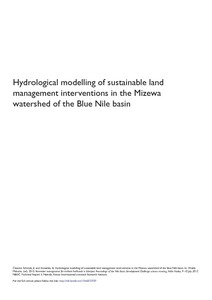Resource information
The current paper discusses the use of hydrological modelling tool to understand sustainable land management interventions in the Blue Nile basin of Ethiopia. A micro-watershed named Mizewa with a drainage area of 27 km2 in Fogera district was selected and instrumented with hydrological cycle observation networks in the year 2011. The SWAT hydrological modelling tool was used to simulate landscape-wide Soil and Water Conservation (SWC) investments. Simulations of the selected investments modelled in this analysis suggest that improvements in infiltration, decreases in surface runoff and decreases in erosion are achievable in the watershed. Further simulations suggest that a landscape-wide approach of terrace and bund construction has the greatest effect in terms of decreasing surface runoff, decreasing sediment yield and increasing groundwater flow and shallow aquifer recharge. A comprehensive landscape investment of terraces on slopes greater than 5% and bunds maintained on slopes less than 5% would decrease surface flow by almost 50%, increase groundwater flow by 15% and decrease sediment yield from erosion by 85%. However, constructing terraces in areas with greater than 5% slope (without constructing bunds in areas under 5% slopes) has a similar effect whereby surface flow and sediment yield decreases by 45 and 83%, respectively and groundwater flow increases by 13%. Residue management also has a significant effect on surface flow and erosion in the Mizewa watershed. Average annual surface flow decreased 17 when adopting residue management on all agricultural land and 26% when coupling terracing on steep slopes with residue management in mid-range slopes. These analyses provide the foundation for understanding feasible outcomes given a more comprehensive investment strategy. Results stemming from the current work can be paired with household level socio-economic data in order to assess program investment alternatives taking into account household constraints to Sustainable Land and Watershed Management (SLWM) investment and maintenance on private and public lands.



